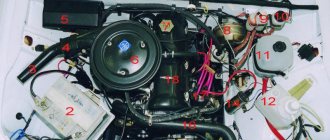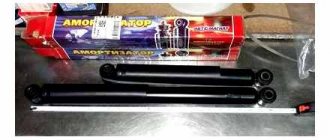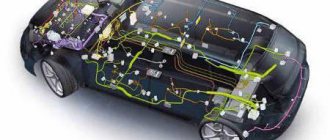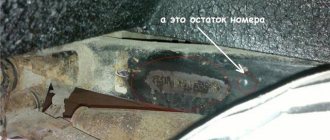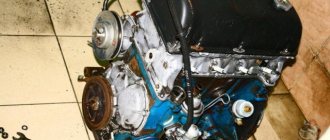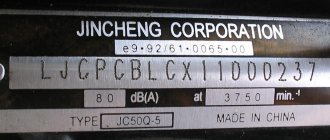There are a lot of motorists in our country. There are only a few car mechanics among them. Therefore, it is not surprising that many novice drivers have a very vague idea of what is under the hood of a car. However, basic knowledge about the main parts of the machine is still necessary, at least in order to be able to guess what exactly could have failed in the event of a breakdown.
There are a lot of “internals” in the engine compartment, but not so many that listing all the details could cause any difficulties. Below is a list of all the parts and components found under the hood of a car, with a brief description of their functions.
1. The engine (aka motor) is the “heart” of the car, without which movement is simply impossible. The engine generates mechanical energy from another type of energy (usually combustion energy) and is located in the middle of the engine compartment.
2. Radiator – necessary for.
So, it all started with my purchase of a car (the choice fell on the VAZ 2107). And as you know, purchasing a car obliges the owner (to begin with) to understand at least a little about its maintenance and, accordingly, repairs. But for me (a novice car enthusiast) everything that was under the hood was a huge secret. Of course, experience is gained over the years, and since I didn’t have the latter (and I knew very little, practically nothing about the “insides” of the car), little by little I began to understand the design features of my Zhiguli. Therefore, so that to my colleagues (novice car enthusiasts) the engine compartment and everything in it does not seem too “dark”, in this article I will tell you what is where and what is responsible for what.
Now about the main thing.
1. Battery – Designed to power electrical equipment when the engine is not running or at low engine speeds. With the engine running.
Many people in our country have cars. But not everyone studied to become a car mechanic, and there is often a situation when a person buys a car without understanding what parts it consists of and what functions these parts perform. Of course, when the car is in good condition and drives well, questions about what drives the car and how it works while driving are of little interest. But when something breaks, then you already need knowledge of the car’s warehouse, at least in order to know what could have broken down. Therefore, everyone needs to know at least the approximate storage of the car. This article will look at what's under the hood.
So, let's list all the parts under the hood of the car. These parts include the engine, radiator, battery, air filter, distributor, fuel pump, expansion tank, windshield washer reservoir, brake fluid and clutch fluid reservoirs, relay and mounting block.
Engine location
Let's start with the engine.
Today almost everyone drives a car, but not everyone is familiar with the structure of the car. If you want to know how your car works, then you have definitely visited the right site. From this article you can glean enough information to know in general terms what components and assemblies your machine consists of. Currently, there are a huge number of brands and models of cars, but almost all passenger cars are designed the same.
Car device diagram
A passenger car consists of the following parts:
body (supporting structure); chassis; transmission; internal combustion engine (gasoline or diesel); engine control system and electrical equipment.
At first glance, everything is simple, but this is only the general structure of the car. For each of the above points, you can write not just an article, but an entire book. But we won't go that deep.
The world's first car with a gasoline engine was patented back in 1885 by the brilliant German engineer Karl Benz. Amazingly, even today the car consists of the same main parts as a hundred years ago - the body, chassis and engine. Let's take a closer look at what a car consists of.
The internal combustion engine (ICE) is the most common type of engine currently installed in cars. Despite the fact that a modern internal combustion engine consists of thousands of parts, its operating principle is very simple. Let's take a closer look at the internal combustion engine device.
The injector is the most popular electronic-mechanical unit in the automotive industry. The design and operating principle of the injector are both simple and complex. Of course, the average car owner does not need to delve into the details of the design of injection systems and their software.
Just as a car will not move without wheels, so without an engine it will not move, unless, of course, you harness a horse in front or push it from behind. In other words, the heart of every car can be safely called what is under its hood - the internal combustion engine. Yes, recently completely different types of motors have appeared, for example, electric ones, but this does not change the essence of the matter. The motor still remains the driving force of every car and will remain so until humanity begins to move something with the power of thought and simply teleport.
Location and components
Due to the fact that people have not yet learned to move in space by sheer force of will, all of humanity continues to actively use fuel engines, the design of which is generally identical and is also located approximately the same - for most cars in the front, and for some in the back or below .
A complex and intricate assembly of a car engine.
But for me (a novice car enthusiast) everything that was under the hood was a huge secret. Of course, experience is gained over the years, and since I didn’t have the latter (and I knew very little, practically nothing about the “insides” of the car), however, basic knowledge about the main parts of the car is still necessary, at least for that. There are a lot of “internals” in the engine compartment , however, not so many of all the parts and components located under the hood of the car, with a brief description of their functions. What's under the hood of a car? So, it all started with my purchase of a car (the choice fell on the VAZ 2107). Of course, experience is gained over the years, and since I didn’t have the latter (and I knew very little, practically nothing about the “insides” of the car), little by little I becameIn this section, you will learn the structure and principle of operation of the car, and tips on repairing and maintaining the car are given. The site materials are divided into groups that make up a separate mechanism.
And now on questions of explanation and thoughts.
1 - frog - meant the light switch Z.H. I didn’t call him that, they called him that name in front of me. But that's not the point. The point is that I don’t seem to have any “chips” on the box, no connectors or holes for any sensors. That's why I asked where to look. I'll take a look one of these days.
Mat. part for novice drivers - What is under the hood of the car
For those drivers who want to start servicing their car themselves and who are simply interested in expanding their horizons, it is vitally important to begin their acquaintance and study of the car with its internals and technologies, which are permeated (stuffed) with the entire engine compartment of the car. Dear readers, in today’s lecture we would like to introduce you to two types of engines of foreign car brands. Many of us (you) could see and personally see the first of these engines in cars from the USA. The second type of motors spread throughout the world and in the 90s became a very popular type of engine, one of which is quite possibly installed in your personal car today.
We would like to point out right away that the information that you will get acquainted with here today is of a general nature, since each of the engines, even of the same volume, the same type and the same technological level, is always purely individual, and sometimes can even be significantly differ in its technological terms from other similar power units.
What is the engine oil dipstick and where is it located? How can you check the oil in the gearbox and what is a radiator, how to handle it, and also where can it be found in the engine compartment? In general, you need all the information, without knowledge of which any car owner simply cannot bear the worthy title of “motorist”.
Therefore, we offer you the following, if you are aware of all the above terms, you can immediately skip this article and move on to reading our other material:
Safety when repairing a car.
Guide: -How to unscrew a rusty bolt.
How to remove scratches on a car.
40 unusual ways to use WD-40.
How to change worn rubber bushings in a car suspension.
How to remove a dent on a bumper.
How they cheat when repairing a car in car services. How to properly wash a car.
How to change the oil in a car.
Guide to winter car operation.
Well, if you, dear friends, have just or recently plunged into the world of cars, then we wish you a pleasant reading. We hope that you will discover something new and not yet explored.
New discoveries under the hood
Precautionary measures when working in the engine compartment of a car. You probably all know that a car is a highly dangerous vehicle on the road. It remains that way in the garage, in the parking lot, and in other similar places. The car contains a huge number of different technical devices that can cause real physical injuries to a person who climbs inside under the hood of the car.
We wrote in detail about all the dangers and precautions when working in the engine compartment in our article: “Safety when repairing a car.” Today we invite you to familiarize yourself with the following points, namely: - How to avoid electric shock, how to protect yourself from toxic technical fluids and not receive mechanical injuries during maintenance of your favorite car.
The precautions described in our article are mainly suitable for deep car repairs. In our case today, regarding a visual examination of the engine compartment and a superficial inspection of the condition of the mechanical parts, it is worth adhering to a few simple and understandable (we hope) instructions for motorists.
1. Any manipulations under the hood, namely, checking the oil level, brake fluid, wear of drive belts, and so on, MUST be carried out with OFF ! The only exception to the rule is checking the oil level in the gearbox. On some car models, the manufacturer recommends checking the oil level with the engine running. We will tell you about this below.
2. Avoid contact with high voltage wires. If this is a prerequisite for under the hood inspection (checking the condition of the wire insulation), that is, first disconnect the negative cable from the battery (indicated by a “-” sign).
3. Also, when working under the hood, do not wear loose clothing. For women with long hair, we advise you to put your hair in a bun so as not to get it dirty on the engine components in the car.
What type of engine is under the hood of your car?
A car engine is a device that converts the energy created inside into mechanical work, which sets the car in motion. Despite all the variety of fuel types and engine types, power units running on gasoline and diesel fuel are the most widespread in the world. Using these internal combustion engines (ICEs) as an example, we will show you the design of the motors.
ICEs (engines) can be divided into two types. Some are located longitudinally, that is, in them the cylinders are located along the central axis of the car.
Other motors are located transversely, in which the cylinders run along the axle shafts of the wheels, from left to right.
In turn, these types of engines are most often divided into in-line and V-shaped. The number of cylinders can vary from 4 to 12 cylinders. Schematically, a V-shaped engine looks like this:
Let's begin with a visual study of the engine compartment of a car with a longitudinal engine.
V-shaped 8-cylinder engine with two rows of cylinders, which are spread out (spaced apart) on the right and left sides of the central axis of the engine, i.e. four cylinders on each side. Hence its designation “V”. The pistons are attached directly to the crankshaft using connecting rods, to which the torque itself is transferred during the working stroke of the pistons. Meet my friends - the American 454 engine is a large, powerful engine with a displacement of 7.4 liters. Such giants are now practically no longer produced, even in their homeland in the USA. However, this motor will be interesting to look at for educational purposes.
See also: Is internal combustion engine the past or the future?
It differs from its V-shaped and in-line counterparts from Europe only in the presence of an outdated carburetor system, as well as an air filter at the top of the power unit and a rather wasteful volume, No. 5 in the table; (the same “pots” can be found under the hood of classic Zhiguli cars and old cars from the Old World of the 80s and 90s). Otherwise, the schematics and arrangement of attachments of the entire engine system are similar to modern ones.
In the photo below, the numbers indicate the elements and systems of the engine; these numbers correspond to the description below.
Classic American V8 454 engine
| 1 Radiator tank (cooling system expansion tank). |
| 2 Power steering reservoir (if necessary, power steering fluid is poured here. Read the vehicle's operating instructions). |
| 3 Brake fluid reservoir (checking the level and adding fluid is carried out through it. Follow the marks on the reservoir; if the fluid has gone below the minimum, fill to the required level. The level will be indicated in the vehicle’s operating instructions). |
| 4 Transmission oil dipstick. |
| 5 Air filter (the metal “pan” above the carburetor is the air filter housing. Old design. In modern injection machines, the filter is located in a separate unit). |
| 6 One of two fuse blocks (the second is located inside the car). |
| 7 Radiator cap (DO NOT open it when the engine is hot! To check for pressure before unscrewing, squeeze the radiator hose with your hand. If the hose is elastic or hard, then there is pressure in the system, DO NOT open the cap!) |
| 8 Engine oil filler cap (motor oil is poured here). |
| 9 Engine oil dipstick (turn off the engine before checking the oil level and wait 10-15 minutes. Now you can start checking. Keep it low within the min and max risk limits). |
| 10 Components of the air conditioning system (it is strongly NOT recommended to climb into it without knowledge. Freon is pumped into the compressor under pressure). |
| 11 Battery. |
| 12 Information labels (in these labels you can find out information about your car model). |
| 13 Hood latch. |
| 14 Drive belt (drives engine pulleys). |
| 15 Generator (produces energy to run the engine and charge the battery). |
| 16 Fan shroud. |
*Note. We used a photo of a classic American made V8 engine. In your particular case, this picture under the hood may be very different from others, especially on modern cars, where the engine may be completely covered with a plastic cover.
Examples of longitudinal engines:
BMW M3
Volkswagen Touareg
Range Rover Sport
Checking the oil level in the gearbox:
Option #1. Transmission oil dipstick. Typically, in front-wheel drive cars, the transmission dipstick is located on the left in the direction of travel of the car; it is used to measure the oil level in the (A) gearbox.
To check the transmission oil level, place the car on a flat surface, switch the automatic transmission to “P” (Parking) mode, and turn off the engine. Check the oil level in the box by pulling the dipstick out of its socket.
Most operating instructions advise drivers to carry out this check on a warm car. And some automakers even insist on checking the transmission level while the engine is running. The oil level should be between the min and max marks*.
*To more accurately determine the oil level, experts recommend checking it several times over an interval of several days. Two - three times, for three - four days.
If there is a shortage of oil, contact a specialist immediately.
Option #2. If there is no dipstick, then the oil level in the box can only be checked through the control plug. A novice mechanic should not perform this procedure. Trust the professionals at the service station (service station).
Now let's take a look under the hood of a car with a transverse engine.
As an example, we presented a power unit produced in 1996. The volume of this engine is 2.5 liters, six cylinders, in-line, 24 valves, which means that the engine uses two intake and exhaust valves for each of the six cylinders. The drive belts are located on the right side in the direction of travel of the machine.
2.5 liters, 6 cylinders, 24 valves
| 1 Radiator tank. |
| 2 Power steering reservoir. |
| 3 Brake fluid reservoir. |
| 4 Transmission oil dipstick. |
| 5 Air filter. |
| 6 One of two fuse blocks. |
| 7 Radiator cap (DO NOT open it when the engine is hot! To check for pressure before unscrewing, squeeze the radiator hose with your hand. If the hose is elastic or hard, there is pressure in the system, DO NOT open the cap!) |
| 8 Engine oil filler cap. |
| 9 Engine oil dipstick. |
| 10 Air conditioning system components (Freon. Danger! Pressure. Leave service to professionals). |
| 11 Windshield washer fluid reservoir. |
| 12 Information labels (information about the types of spark plugs, air conditioning systems and other systems of your car model). |
| 13 Hood latch. |
| 14 Access to shock absorbers. |
Attentive readers may have immediately noticed that there is no battery in the engine compartment (rechargeable battery) and this is the honest truth, it is not here. It is located inside the car. A relatively uncommon practice, but friends should know about it. What if you have to change the battery, but you can’t find it..?
The most common places to install a battery are in the trunk or under the rear seat of a car. On some modern car models there may be several such batteries, that is, one battery is located in front under the hood, and a second small, auxiliary battery can be located directly in the trunk. It is interesting that on the same car models in different configurations, the batteries can also be located in different places. For example, in the Mercedes-Benz W124 model with a 2.5 liter diesel engine, this battery is located under the hood, while in the same model, but with different engines, the battery was installed directly in the trunk.
But automakers don't stop there. On some models of Chrysler cars, the battery (battery) could be found in front of the left front wheel..(!) To access the battery, it was necessary to turn the front wheels of the car as far as possible to the left and only then in the wheel arch could one find a removable panel behind which the battery (battery) was hidden ).
Answers on questions
What is an internal combustion engine?
An internal combustion engine is an engine in which fuel is burned directly in the working chamber (inside) of the engine. The internal combustion engine converts thermal energy from fuel combustion into mechanical work.
What is a gearbox?
A gearbox is a mechanism for changing the torque transmitted from the engine crankshaft to the drive wheels, for moving the car in reverse and for long-term disconnection of the engine from the transmission while the car is parked and when it is moving by inertia (coasting).
What is a car suspension?
Suspension is a set of parts, components and mechanisms that play the role of a connecting link between the car body and the road.
Brake system
An important part of the machine that ensures safe driving is the braking system. Its main purpose is to forcefully stop a moving vehicle. It is also used when it is necessary to sharply reduce the speed of the car.
The brake system is of the following types according to the type of drive:
- mechanical;
- hydraulic;
- pneumatic;
- combined.
Modern passenger cars are equipped with a hydraulic brake system, which consists of the following elements:
- brake pedals;
- main hydraulic cylinder of the brake system;
- master cylinder filling tank for filling brake fluid;
- vacuum booster, not available in all models;
- front and rear brake piping systems;
- wheel brake cylinders;
- brake pads pressed by wheel cylinders to the wheel rim when braking a vehicle.
Brake pads are either disc or drum and have a return spring that presses them away from the wheel rim when the braking process is complete.
Learning to understand cars
The ability to understand machines is a fairly broad concept. For some, it is enough to distinguish one model from another. The same people whose profession is related to cars put a much broader meaning into this concept:
If you work, for example, in a company that sells spare parts or in an auto shop, then according to your job description you are simply required to have extensive knowledge:
If you have ever had to buy spare parts, then you know that it is enough for a good specialist to show this or that spare part - the brake wheel cylinder, the second gear gear, the main or intermediate shaft of the gearbox, the clutch cable, the release bearing, the feredo disc - he will name them without any problems brand, will tell you what car it is from, and most importantly, will tell you exactly what it is. He will also easily select the part you need from the catalog - from a rubber sealing ring or cuff, to an assembled distributor or gearbox rocker.
It is clear that such a skill comes only with experience. We will try to give basic recommendations on our website Vodi.su.
Wiring diagram for Gazelle 402 engine: do-it-yourself replacement
Pedals in the car: location and purpose
The design of the GaZ 3302 made it possible to place the power units and driver’s cabin as compactly as possible.
This made it possible to install a large cargo platform on the relatively small body of the GAZ 3302. At the same time, the car turned out to be easy to control and maneuverable.
The car was immediately liked by both representatives of air transport companies and industrial enterprises, as well as private entrepreneurs, farmers and businessmen. The GAZ 3302 model, whose fuel consumption (11.5 liters per 100 km) does not exceed Volgov’s, immediately became an indispensable assistant in industry, trade and agriculture. The Gazelle has truly become a people's car, just as the GAZ AA lorry was once. The small size of the GAZ 3302 and small turning radius (5.5 m) made it popular for use in large cities, ports, warehouses and household plots.
Brief description and technical characteristics of Kamaz 4310 on this page.
The brake system of KamAZ 5320 and the diagram are in this publication.
Advantages and disadvantages of using stretch marks
The popularity of car metal braces is due to their affordable cost and ease of use of this type of tuning. Their advantages also include the following:
1) improving vehicle maneuverability;
2) increasing body rigidity indicators;
3) adds stability on the road;
4) eliminates body rocking;
5) can be used as an additional motor support;
6) lateral rolls in turns are reduced.
Depending on their design and method of attachment, such braces may differ in their functionality. Therefore, it is necessary to select certain types of such accessories after consultation with a specialist. Like any other type of tuning, automotive metal bracing has its own specific disadvantages that must be taken into account when choosing these accessories.
First of all, the functionality of the steering wheel deteriorates, the car may turn worse, and in some cases the car’s turning radius increases. Remember that the hassle-free use of such products will largely depend on their quality of manufacture. In no case should you save on such tuning by choosing Chinese braces that are not of very high quality, which do not have the proper strength and are not always suitable for certain cars.
Ideally, you should choose tuning elements that are made by leading auto studios that specialize in certain car brands. Directly attaching such elements that increase body rigidity does not present any particular difficulty. All that needs to be done is to tighten them on the racks, while acting strictly according to the instructions. High-quality extensions will have the necessary instructions, which greatly simplifies installation work, which can be easily completed by any car owner, even if he does not have any special experience in car repair.
Let's sum it up
Car struts are the simplest elements of car tuning, which are usually mounted under the hood on car struts; they improve the rigidity and behavior of the car, while being affordable and easy to install. Remember that if you prefer a calm and measured style of driving, then such accessories will simply be useless, since their effectiveness can only be assessed during extreme aerobatics at high speeds. Also take into account the fact that you should not skimp on the quality of stretch marks when purchasing such accessories from reputable manufacturers.
02.04.2020
Preparing for washing - the engine loves cleanliness
A working engine should not have any leaks of working fluids. It is imperative to periodically remove dirt and dust for the following reasons:
- Accumulated dirt and dust are a good heat insulator, which can lead to overheating of the power unit. In addition, fuel consumption increases and engine power decreases.
- A clean engine makes it easier and faster to carry out maintenance: replacing working fluids, filters, spark plugs, etc. Specialists at a service station with clean cars do their work better.
- Dirty threaded connections are more difficult to unscrew, and parts covered with dirt wear out faster.
- A dirty engine increases the risk of fire. Oil that appears on the engine or other parts of the car can ignite when the exhaust gases ignite from a spark if the exhaust manifold is not working properly.
- With a clean power unit, you can immediately detect oil or fluid leaks and quickly fix the problem before it becomes more serious.
- Contamination can cause electrical leakage, which can make it difficult to start the car.
- A car with a clean engine has an attractive sales appearance, which makes it possible to sell the car at a higher price.
Thorough preparation of the unit before washing is the key to a high-quality result
We recommend: How does a car’s fuel level sensor work? 11 possible causes of the malfunction and its repair
We recommend that you read
- How to flush a cooling radiator without removing it - cleaning the outside and inside
- Flushing the engine when changing the oil - necessity and correctness
- Diesel particulate filter - what is it and how to maintain it
Before washing the engine compartment of a car, you need to carry out some preparatory steps that will help protect wiring, electrical devices and parts that are sensitive to moisture from penetrating moisture.
At the preparatory stage, you need to perform the following sequence of actions:
- We de-energize the car by disconnecting the negative terminal from the battery or removing the battery from the car to make washing safe.
- Unscrew the protection from the engine compartment.
- Close the air intake to prevent water from getting inside the engine.
- Using tape and plastic film, we protect all connections, connectors, sensors and wiring from moisture. Electrical contacts and connectors can be treated with a special water-repellent aerosol, which provides effective protection against moisture.
- At this stage, we disconnect the parts and components that interfere with getting to the engine.
Having carried out the preparatory work, you need to prepare several brushes, a bucket of water, clean rags, a Karcher (if you don’t have one, you can take any hose), detergents and chemicals. It is better to use brushes with a long handle, this will make it possible to reach hard-to-reach places. With the help of a Karcher, thanks to the high pressure, it is easy to wash away dirt and oil.
Cabin Gazelle
The Gazelle's cabin is fraught with one peculiarity. As soon as the sliding glass of the door freezes a little in winter, an inexperienced passenger, trying to open it, will break the window regulator. The rollers are made of plastic, so they burst immediately, and they are sold only complete with the mechanism. In the window lift units, the quality of the plastic is disgusting; the plastic tube, running up and down, tends to break. The cable immediately weakens and comes off the drum groove, jamming the entire mechanism. It should be noted that the left and right window regulators are not interchangeable. You can easily modify the assembly yourself: simply replace the plastic shells with metal ones.
We examined the main problems of parts and components of the cargo Gazelle. The main advantage of this car is, of course, its low cost. Therefore, decide for yourself which truck to choose.
Useful tips
- Before using the detergent, you should carefully read the instructions.
- Be sure to first prepare the engine for washing.
- If possible, you should first remove dirt from the surface by wiping the engine with a rag.
- When washing a car with water, be sure to dry it with a compressor.
- Then you need to check the car. If it starts as usual, then everything was done correctly. If the motor stalls or extraneous noise appears, something went wrong during the washing process.
Cleanliness is the key to the health of the machine. The car enthusiast will be sure that the iron horse will not fail at the wrong moment. The main thing is to know how and with what to wash a car engine. Try to clean the engine of your iron horse at least once a year. Then many breakdowns can be avoided.
Electrical equipment
One of the most complex systems of passenger cars with many different elements and wires connecting them, entangling the entire car body, is electrical equipment, which serves to provide electricity to all electrical devices and electronic systems. Electrical equipment includes the following devices and systems:
- battery;
- generator;
- ignition system;
- light optics and interior lighting system;
- drives for electric motors of fans, windshield wipers, window lifts and other devices;
- heated windows and interior;
- all electronics of the automatic transmission, on-board computer and protective systems (ABS, SRS), engine management and others;
- power steering;
- anti-theft alarm;
- sound signal.


